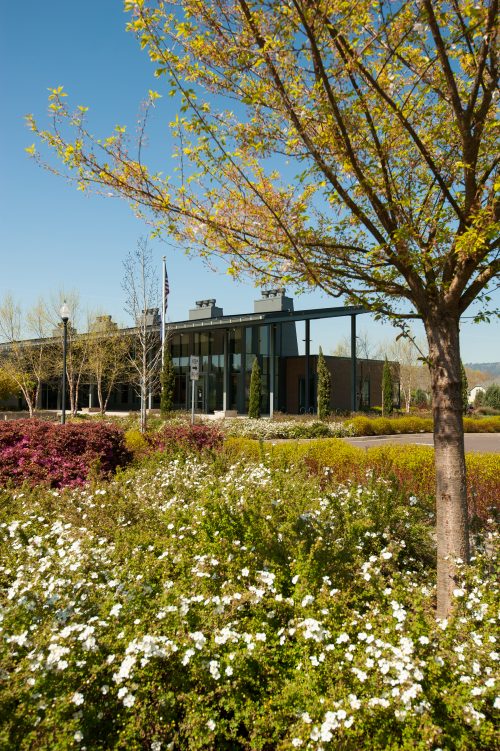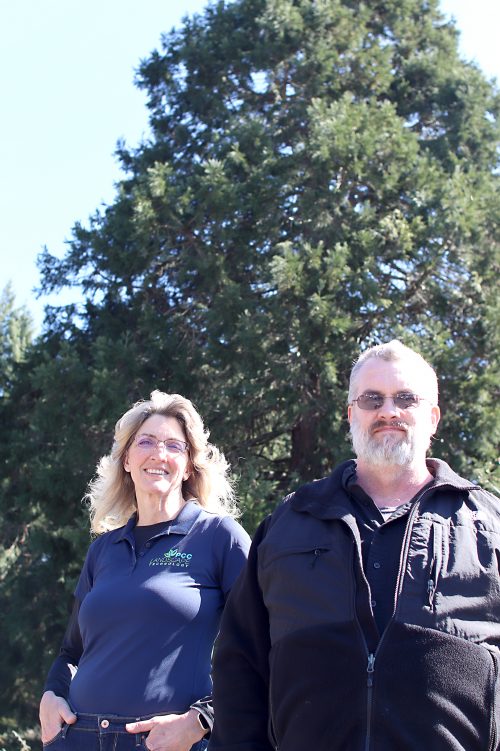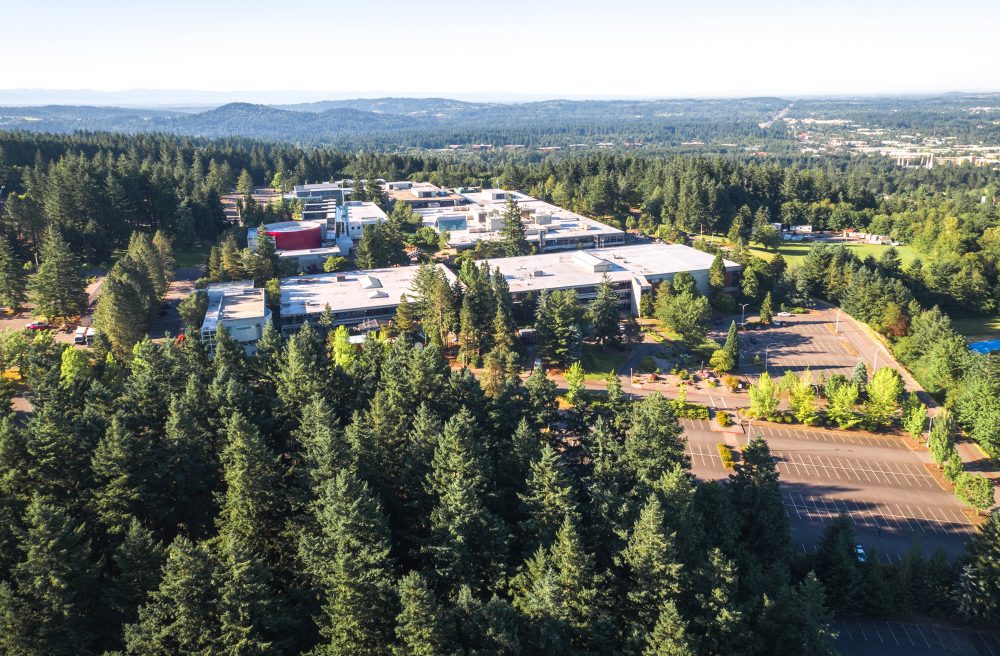This content was published: March 30, 2020. Phone numbers, email addresses, and other information may have changed.
PCC takes stock of its growing assets – its 3,800 trees
Photos and story by Katherine Miller
Money may not grow on trees, but a recent survey of Portland Community College’s own trees do in fact represent a major financial asset.
The district-wide survey, conducted last fall by Bartlett Tree Experts and funded by the 2008 voter-approved bond measure, documented that PCC has about 3,800 trees, which represents a retail value of more than $13 million. This tally doesn’t even include the thousands of trees that are in a dense forest behind the Rock Creek Campus.
Anne LeSenne, an instructor with Rock Creek’s Landscape Technology Program and one of the college’s two certified arborists, said the survey made clear how important it was for the PCC to take stock of its trees — not just for financial reasons but also for helping PCC meet the sustainability goals in its Climate Action Plan [pdf].
“The value we have on each of these campuses is incredible,” LeSenne said. “People didn’t realize that. They say, ‘Yeah, we like trees, they make us feel good and make the campus look great.’ They didn’t realize how valuable some of these trees are.”
LeSenne said people also often overlook trees’ many other benefits, such as:
- Removing harmful particulates from the air.
- Lowering energy costs by shading buildings from the sun or shielding them from cold wind.
- Reducing storm water runoff.
- Filtering contaminates from the soil.
- Increasing biodiversity and wildlife habitat.

The project was managed by Krista Phillips, managing architect with PCC’s office of Planning and Capital Construction, which contracted with Bartlett to visit each PCC location except for Downtown Center. The arborists placed a numbered brass tag on each tree trunk and identified 50 data points, including common name, botanical name, height, canopy size and GPS coordinates.
Sean Rinault, regional inventory arborist with Bartlett, explained that his firm typically works on large commercial and industrial sites where he doesn’t often encounter the diversity he saw at PCC.
“There were several species of trees (at Rock Creek) that were unknown to me when I first encountered them, such as medlar, Amur cork tree, knobcone pine, and pawpaw,” he said. “There were even species I’d learned before, but aren’t in the Pacific Northwest list of common tree species maintained by the International Society of Arboriculture and needed to be added. It was a challenge at times but definitely a welcome departure from seeing the same tree species all the time.”
The findings were uploaded to ArborScope, Bartlett’s interactive landscape management website where the information is searchable using the many data points Bartlett gathered, including using Google Earth satellite imagery. Jack Lussier, grounds manager for PCC’s Facilities Management Services (FMS) and administrator of the ArborScope application, said the program has been a big help to FMS staff.
“This tool is great for many things in relationship to the tree work we do here at the college. The software is easy to use and user friendly, and everyone can access it from their computers or cell phones,” he said. “We spend about 10 percent of our time looking after the trees in the district. The city of Portland requires a permit for removing trees over 12 inches DBH (diameter at breast height). This software allows us to track and report to the city the trees we have removed and planted.”
Lussier also said that ArborScope helps PCC maintain its certification as a Tree Campus USA member of the Arbor Day Foundation, a nonprofit organization that, among other programs, certifies tree conservation and education efforts by communities, schools, colleges and health institutions.
“We can now ID the tree from the software and not question whether we’re talking about this tree or that one,” he continued. “Tree managers can now systematically track and plan for tree-maintenance needs.”
LeSenne added that the database is enhancing how the Landscape Technology Program teaches curriculum. The staff is also working with PCC’s District Campus Tree Advisory Committee to integrate the college’s canopy coverage with its Climate Action Plan. PCC’s goal is to increase its canopy from its current level of 19.7 percent to 30 percent, a level that many cities — including Portland — have set.
“There’s excitement about having this information and what we can do with it,” said LeSenne. “Let’s plant more trees, let’s take better care of our trees, let’s protect our trees. We’re moving in that direction, and I think it just takes educating the student community, the staff, educating our architects and engineers when they’re making new designs. We’re helping educate everyone so that we can be more sustainable in all of our actions.“



I love all the trees at PCC! A lot of them, however, are badly in need of pruning. Is there a plan to do this?
Thank you,
Linda
Hi Linda, FMS said our pruning standards follow the city of Portland’s title 11 tree standards. They have been planting more native and conifers that require less work load (pruning). And Rock Creek’s trees are left in their natural form for the LAT classes and under Tree Campus USA standards. See more info: https://www.arborday.org/programs/treecampususa/ or https://www.portlandoregon.gov/citycode/66002
First, thank you for the very informative article on the trees around PCC. This is indeed one of the most beautiful campuses in the country, much in thanks to the variety of trees growing there. I find Linda’s post and your reply interesting. As a tree service professional, we strive to trim and prune trees in a way that promotes healthy growth in the trees. Yet, I also see the value in students observing trees in their natural state. My question would pertain to this as well. How often do trees have to be pruned on campus to avoid the dangers that can be seen in trees that are not properly maintained and are those services done by arborist students or by a tree service?
Thanks Josh
Owner of Duluth Tree Service Pros
Josh, After we had the Tree Survey done, we have been able to prioritize the work that needs to be done better than ever before. The Grounds crew on each campus works to take care of the pruning needs of the trees, if they are able to do the work without climbing. Occasionally we need to hire a professional to come do work. The only campus that has any tree pruning done by students is the Rock Creek campus, as that is where the Tree Care class is taught. Brian French has been a guest speaker, and demonstrated how to make Habitat trees. Many of the trees on campus are left in their natural state, and only pruned for safety. Deadwood is valuable habitat for many creatures, and when safely possible, we leave deadwood to provide a more balanced ecosystem.